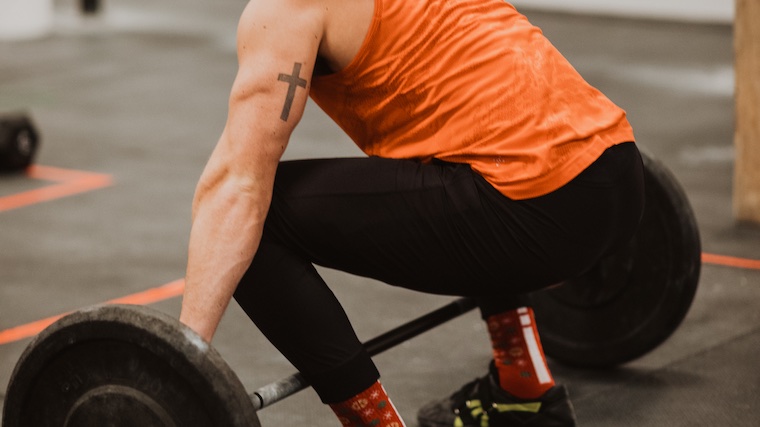As vaccinations roll out, more and more people are feeling comfortable returning to their local CrossFit gym. Many of these people, however, have had severely altered training habits for the last year or so.
Some have outfitted their homes with some pretty impressive home gyms, some have been working out at home with just a dumbbell, and some haven’t been doing much of anything.
When designing programming for people coming back into the gym after a long layoff, there are several things that gym owners and coaches should keep in mind.
Athlete Safety
In this article, we will focus on people who were training seriously before the pandemic, but have not been able to train at home with full equipment.
The worst fears of every neurotic athlete out there are not true: you don’t lose everything by taking a week off from training. In fact, you don’t lose everything even by taking a year off of training.
People coming back into the gym are in a particularly precarious situation because they can still do a lot of things that they shouldn’t be doing. Newbies often stop themselves well short of their physical limits. Experienced trainees, however, are much better at overriding the “impulse to stop or slow down.” They also have expectations of their performance informed by their previous abilities. As such, these folks are often capable of doing something that they shouldn’t be doing.
It’s important that coaches communicate with these athletes about their expectations for themselves as they return to training.
Many people have a “go hard or go home” attitude — counterproductive in normal times and outright dangerous when returning to training after a layoff. When communicating with these folks, it is important to help them understand their “rate of perceived exertion” or “how hard they are working during a session.” By limiting rate of perceived exertion, these athletes can help themselves ease back into training without biting off more than they can chew.
Something like this might be a useful way of framing the discussion:
“As you get back into the gym, you may feel like some things are more difficult than you expect while others feel surprisingly good. Still, it’s probably smart to avoid pushing yourself too hard for at least a few weeks. If your normal hard workout feels like a 9 or a 10 out of 10 in terms of effort, try capping yourself at a 6 or a 7 for your first weeks back in the gym.”
Training Volume for Returning CrossFitters
When programming for people returning after a long layoff, we need to be especially careful with the volume of eccentric contractions in our programs. The eccentric contraction is the “lowering” phase of a lift — think dropping down on a squat or lowering yourself after a pull-up — and is the part of lifting during which the most muscle damage occurs. This is the reason that people worry about rhabdomyolysis — a condition caused by excessive muscle breakdown releasing proteins into the blood — when programming high volumes of movements like GHD sit-ups, lunges, and calf raises.
Returning athletes probably still have the strength, drive, and movement skill to do high volumes of eccentric contractions that they aren’t prepared for. Not only are we concerned with more serious conditions like rhabdo, but we also want to avoid making athletes so crushingly sore that they can’t return to the gym for days.
Depending on the type of program you’re following, having a rough idea of the total volume of specific movement patterns in a given session as well as across a week is a great way to avoid overloading people who are getting back into the gym.
This doesn’t need to be super detailed and specific, but a rough estimate of how many reps per week athletes are doing of squatting movements, hinging movements, kipping movements, and pressing movements can give you some baseline numbers to build off of. Watch for big jumps in any of these areas and try to avoid large volume increases of 50% or more.
Simultaneously, take special care with movements that are known to create soreness for people who haven’t been doing them: lunges, pull-ups, squats, and kipping movements come to mind.
It may also be smart to focus on movements with less eccentric loading, like rowing, biking, sled pushing, and carries.
Muscle Strains from Heavy Lifting
In addition to the volume of specific movements throughout the week, coaches and athletes should also be cautious with reintroducing intensity in lifting.
While strength tends to be maintained surprisingly well — even with long layoffs from the gym — athletes who haven’t been lifting heavy are particularly prone to muscle strains.
For myself, I know that I have to be very careful with heavy back squatting when returning from time off of training. Just about every time I’ve returned to squatting heavy after significant time off without easing back into it, I’ve strained an adductor on my second or third set heavier than 135#.
I’ve seen similar issues in athletes with low back strains on hinging movements or groin strains on lunging movements. These types of muscle strains can be thought of as an overreaction to muscle tension — if we gradually reintroduce loading, we can retrain our system to expect the tension we create while lifting and avoid these kinds of strains.
The discussion on rate of perceived exertion above is particularly germane to any sort of heavy lifting. Similarly, we can use exercises that limit the amount of weight athletes can lift, while still creating a feeling of difficulty.
View this post on Instagram
The double overhand deadlift without hook grip is often limited by grip rather than by pulling strength, for example:
- Double overhand deadlift, no hook grip
- 4×4; Across; Rest 2 min
- (Reset each rep. Not touch-and-go.)
Similarly, the double kettlebell front squat is very awkward and difficult at loads much lower than an athlete’s front squatting potential:
- Double kettlebell front squat
- 3×8-10; Build as able; Rest 2 min
Conditioning and Intervals
Even if people have been training consistently, they will likely find themselves falling apart much more quickly than expected on high intensity mixed modal conditioning pieces.
Again, this doesn’t mean that they have “lost everything.” Instead, the ability to tolerate the fatigue associated with high turnover couplets and triplets is a very specific skill. Communicating to athletes ahead of time that they will be getting tired much earlier than they expect is key so that they can go into workouts with appropriate expectations.
For returning athletes, we ideally want to put them in situations where they are able to build a base of support for future work without just hammering themselves into the ground. Simultaneously, we need to be aware that people want their conditioning work to feel “hard.” So, can we give athletes some of what they want without giving up on what they need?
There are a few ways to do this.
One is to use self-limiting movements that force pacing or recovery in the middle of a conditioning piece. Things like isometric holds or awkward carries can force athletes to slow down their effort and avoid immediately blowing up.
Something like this could work:
4 rounds:
40 double-unders
30 air squats
20 Dumbbell snatches, alternating
50’/side single-arm KB front rack carry
-Rest 1 min
We can also use escalating pace scenarios to force athletes to develop better control of their pacing. These kinds of workouts often work best with cyclical work in running, rowing, or biking so that athletes can better modulate their effort.
That may look something like this:
4 rounds @ escalating pace per round:
21 row calories
15 wall balls
9 Russian Kettlebell swings (tough)
-Rest 2 min
(Start at moderate pace each round and escalate pace so that the last round is at tough effort.)
Conclusion
Returning to the gym is going to be an exciting time for many athletes, as they are chomping at the bit to reclaim some of their pre-pandemic fitness routine.
These athletes are in an interestingly fragile state, though, as they are likely both in much better shape and much worse shape than they expect.
The most important thing coaches can do is get in front of these athletes to control expectations and give them a framework for keeping their effort well below maximum for at least several weeks.
In addition to that, coaches can utilize self-limiting exercises, escalating pace intervals, and low eccentric cyclical work to help athletes ease the transition back into the gym.
Images courtesy Todd Nief/Omnia

